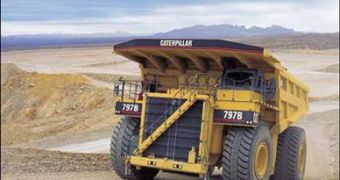The Caterpillar 797 model, weighing 700 tons, is already known as the largest truck in the world and used in tasks that require dimensions that support a load of 240 tons. But such tasks, like mining, for instance, are usually highly dangerous jobs and provide extremely difficult environments to drive through. That's why the Carnegie Mellon University technical experts joined Caterpillar engineers in order to convert these large vehicles into robotic versions.
Basically, this means that the 700 ton monster relying on a 24-valve engine that yields a 3,550-horsepower and up to a 68 km/h (42 mph) speed would be driven around by a computer software. Among the top-notch technology gadgets that will spice up the board of the giant truck will be GPS devices that will constantly monitor its position, lasers tracking possible obstacles (rocks or holes), visual equipment that will identify and measure the obstacle and a software that will inform the automatic driver to avoid it and by how much.
Switching to an automated driving process will ensure a better production efficiency by about 100%, while also removing human drivers from the dangerous job of leading the huge vehicle through the tough conditions around a mine. “I personally think this is a good idea,” said Mark Campbell from Cornell University, quoted by Discovery. “The safety of miners will be greatly improved because of the lighting issues, fog, dust and other conditions that make driving around a mine difficult.”
This is not the first truck to be modified in this way, though, as the Japanese Komatsu vehicles have been performing this automated driving chore for a while at the Chile-based Gaby mine. But the future of automation is not only reserved to large vehicles. According to Tony Stentz, a CMU professor involved in the research, “Autonomous vehicle technology is pretty much in its infancy”. He hopes that during the following five to ten years, this automation technology will also be applied to other fields, ultimately reaching regular cars.

 14 DAY TRIAL //
14 DAY TRIAL //